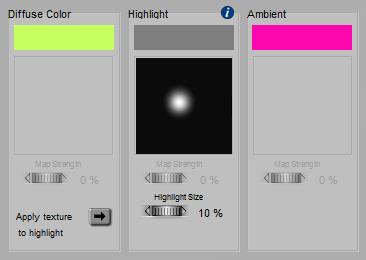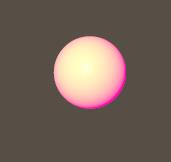For short: ambient make objects glow, and emit light independent of any lighting sources in the scene. This is to represent led-lights, or some phosphorescence of fluorescence effects.
 =>
=> 
Note that light, and hence ambient glow as well, serves the visibility and presence of objects in the scene while shadows serve shape and surface structure details of an object. So, when using ambient glow, I will gain object visibility but I will lose some of the shape and surface details, and hence I’ll “flatten” the image. In other words, I should not overdo.
Intermediate
In Poser, Ambient (both Simple and Advanced interface) as well as its equivalent Translucence (Advanced interface only) will make an object glow. There are various reasons to have an Ambient component in the materials definition.
First, the truly legitimate reason, is to implement the objects glow as it appears in real life. Led-lights, or some phosphorescence of fluorescence effects, were already mentioned above.
Second, considered a half-legitimate reason, is to represent translucency as can be found in skin, wax candles and alike, in a render setup which is poor on raytracing and hardly supports sub-surface scattering. Early Poser versions, PC’s with less computing power, or the requirement for a massive output stream as in animations might be the reason for this. A resource intensive process is then replaced by a much faster process with – sometimes slightly – less realistic results.
Third, nowadays considered almost an illegitimate reason, is to compensate the object for poor lighting conditions at the spot. Adding some local point- or spotlights, and especially switching to indirect lighting (IDL) conditions supported by modern Poser versions, resolve the lighting issue the way it should be.
Some additional notes:
- In contrast to Diffuse and Specular, there is no angular distribution of the light send towards the camera. Edges are as intense as areas in the middle part of the object, which makes it harder to distinguish shape details. This is the way nature works too, by approximation.
- See this article on plugging Material Room nodes into the Ambient (and/or Translucency) slots of a PoserSurface material definition.
- Ambient (and/or Translucency) generate some local lighting levels which are independent of the intensities of external sources of light. Hence, when I decide to dim the lighting levels in my scene to avoid overlighting, I’ve got to dim those Ambient aspects of the materials as well to keep the balance.
- Ambient (and/or Translucency) are proper candidates for turning an object into a light source under indirect lighting (IDL) conditions. This is the way to make an all surrounding dome object lighting the entre scene. I may have to pump up the intensities though.
Recommendations:
- To prevent artefacts in rendering when applying the Gamma mechanism (recommended, available in PoserPro and Poser 10 and up) the Value setting should be kept to 1.0 only (or 0.0 but no intermediate values).
- To prevent overlighting when combined with other aspects of lighting and material definitions, it’s recommended not to exceed a (100% – (Diffuse+Specular)) brightness in the Color-swatch and maps (or in the Value setting when not applying Gamma). So with Diffuse set to 70% and Specularity set to 20%, Ambient should be limited to 10% at most. See this article on details.